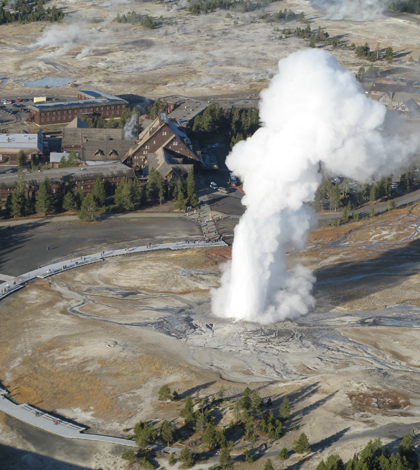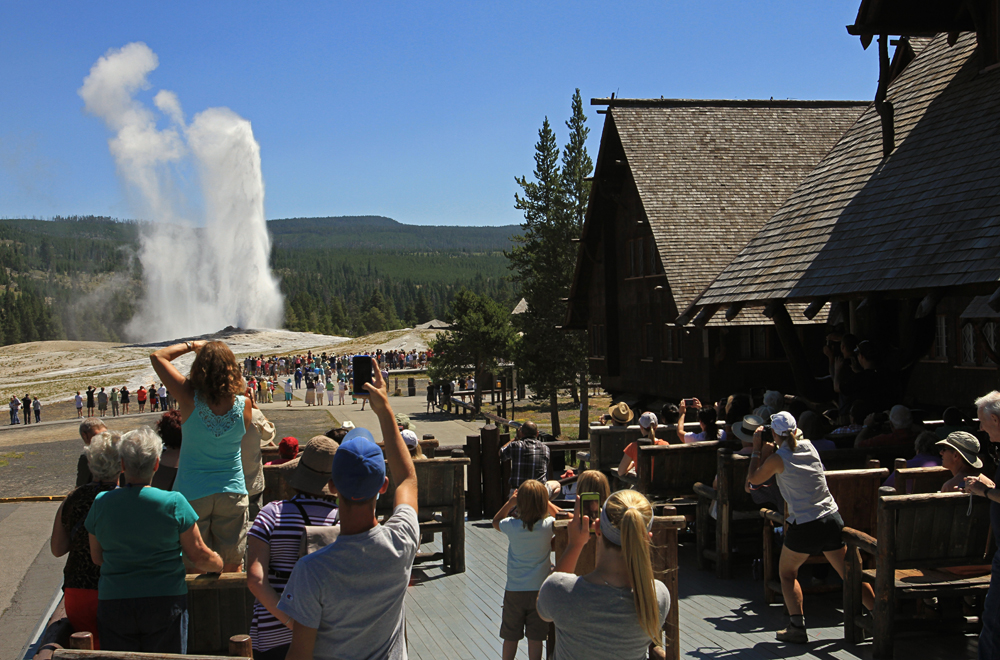Old Faithful report advises on protecting the resource while facilitating 3 million visitors

Old Faithful erupts a few hundred yards from the Old Faithful Inn (Credit: Cheryl Jaworowski/National Park Service)
A few hundred yards from where Old Faithful blasts thousands of gallons of boiling water into the air at famously predictable intervals, the Old Faithful Inn sits as the centerpiece of the most developed settlement in Yellowstone National Park.
The inn was built light on the land in 1903. But in the intervening century, the log hotel expanded and additional buildings and parking lots sprouted up nearby as the sensitive thermal area evolved to accommodate around 3 million visitors a year.
“If we just came upon Yellowstone National Park right now, we would not put the major developed area adjacent to and partially in the geyser basin,” said Henry Heasler, a park geologist at Yellowstone. “There’s a direct competition between having all those people there and protecting the resource.”
Instead of undoing the development of the past hundred years, the National Park Service is looking to manage that competition by making sure they’re guided by the best available science. That’s why the agency in 2013 convened the Old Faithful Science Review Panel, which Heasler co-chaired. The panel issued its report this month, summarizing the state of scientific knowledge about the Old Faithful area, as well as suggesting future studies and techniques for managing people and property.
The panel of seven experts in geology and hydrology met in June 2013 to hear presentations from park employees, law enforcement, historians, researchers and other panel members. Their conclusions include that the thermal features and subsurface plumbing that control the geysers are ever-changing and fragile, and that human activity has disturbed the system in the past.
And given that the uncertainty about just how the system works will persist no matter how much scientists study it, Heasler said the park would be best off following the precautionary principle when considering new construction or invasive upkeep. That would mean that, in a nutshell, they should hold off on any projects unless they’re certain it wouldn’t harm the thermal system.

Yellowstone National Park has to facilitate millions of visitors each year while protecting the thermal resource. (Credit: Jim Peaco/National Park Service)
The panel also suggested a series of additional studies and monitoring initiatives, including installing groundwater monitoring wells and occasionally measuring the discharge from Old Faithful eruptions. The amount of water leaving the geyser hasn’t been well studied, and the data would go a long way toward detecting long-term changes in the system. But it’s not a simple endeavor.
“The challenge you’re getting into is people don’t come to a national park to see the monitoring network,” Heasler said, “Go to one of the Old Faithful webcams. Sit there and look at that beautiful picture of Old Faithful and think what it would look like to have it all sandbagged so that you could collect and get a good flow value.”
On the other hand, more studies based on less-invasive remote sensing techniques like ground-penetrating radar are no-brainers, he said.
Groundwater monitoring wells could give some insight into reasons behind the increasing time between Old Faithful’s eruptions, which has grown from an average of around 66 minutes between blasts in the 1960s to more than 90 minutes in 2013.
Given the geyser’s name, it’s strange to think of Old Faithful’s eruptions eventually fading away altogether. It could happen in the distant future, Heasler said. But it’s not the park’s role to preserve individual geysers, which naturally start, stop and change intervals, he said. It’s the park’s job to preserve the processes that control the regional thermal resource as a whole.
“Will Old Faithful eventually stop? Definitely. I’m thinking about this on a geologic time scale. It’s going to stop, it’s going to change,” Heasler said. “What we’re trying to do, and what the panel is trying to do, is to a certainty be able to say that if it stops, it wasn’t due to humans.”
Top image: Old Faithful erupts a few hundred yards from the Old Faithful Inn (Credit: Cheryl Jaworowski/National Park Service)





0 comments